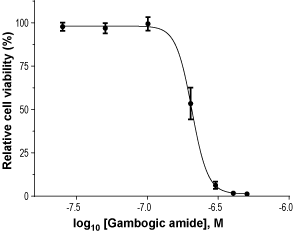Overview
Gambogic amide, is a small molecule that mimics nerve growth factor (NGF) and is a selective agonist of TrkA receptor that strongly induces its tyrosine phosphorylation and downstream signaling activation.
Gambogic amide interacts with the cytoplasmic juxtamembrane domain of TrkA receptor and triggers its dimerization. It selectively binds, activates and upregulates the expression of TrkA receptors at nanomolar concentrations but not TrkB or TrkC.
Gambogic acid is a major active ingredient of gamboge, a resin exuded from the Garcinia hanburyi tree in southeast Asia. Gambogic amide also possesses neurotrophic activity in various neural injury animal models and prevents glutamate-induced neuronal cell death1,2.
Gambogic amide shows antiapoptotic activity and demonstrates EC50 value of 5 nM3.
Specifications
Technical Specifications
Biological Activity
- Jang, S.W. et al. (2007) Proc. Natl. Acad. Sci. U.S.A. 104, 16329.
- Chan, C.B. et al. (2009) Oncogene 28, 3825.
- Shen, J. and Yu, Q. (2015) Pharmacol. Rep. 67, 217.


